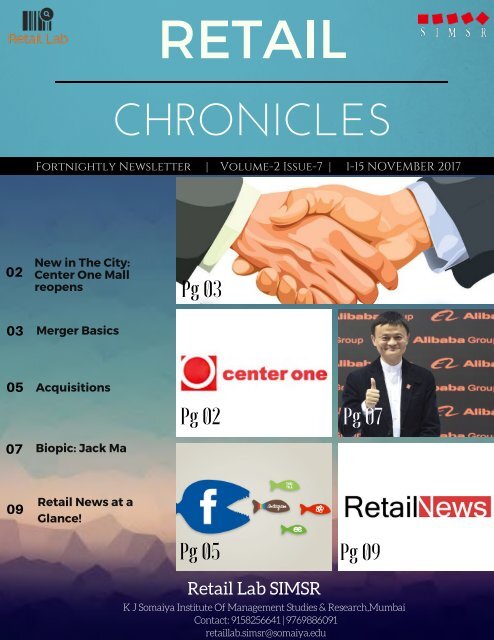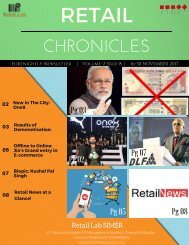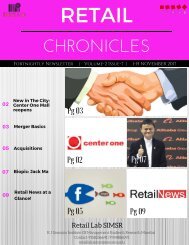Retail Chronicles_Issue 7
You also want an ePaper? Increase the reach of your titles
YUMPU automatically turns print PDFs into web optimized ePapers that Google loves.
in The City:<br />
New<br />
One Mall<br />
Center<br />
Biopic: Jack Ma<br />
News at a<br />
<strong>Retail</strong><br />
Glance!<br />
J Somaiya Institute Of Management Studies & Research,Mumbai<br />
K<br />
9158256641 | 9769886091<br />
Contact:<br />
RETAIL<br />
CHRONICLES<br />
Fortnightly Newsletter | Volume-2 <strong>Issue</strong>-7 | 1-15 NOVEMBER 2017<br />
02<br />
Pg 03<br />
reopens<br />
03<br />
Merger Basics<br />
05<br />
Acquisitions<br />
Pg 02<br />
06 Pg 07<br />
07<br />
09<br />
Pg 05<br />
Pg 09<br />
<strong>Retail</strong> Lab SIMSR<br />
retaillab.simsr@somaiya.edu
"The cost of being wrong<br />
is less than cost of doing<br />
nothing"<br />
Seth Godin
NEW IN THE CITY<br />
By Vikas Khetan<br />
Centre one which was navi Mumbai's oldest<br />
mall located in Vashi and which was closed<br />
down in 2015 due to tough competition from<br />
other malls nearby, was re-opened again by<br />
future group this Diwali. It was after a major<br />
business deal with future group that the mall<br />
was given a new life. Centre one is of Nandu<br />
Group and companies.<br />
Centre one closed down its business in<br />
March 31, 2015. As it was Navi Mumbai's<br />
oldest mall, a lot of nostalgia was attached<br />
with it and old timers still recall it. So<br />
naturally reopening it will bring back a lot of<br />
memories. It was closed down because of the<br />
loss it was making. The area already had 3<br />
big multiplexes cum malls and compared to<br />
them, Centre one was not competitive but<br />
also very old fashioned. Despite that the<br />
brand was still very famous and well known<br />
and still popular among old timers. From<br />
start the group was saying that they will<br />
return after 2 years and indeed they<br />
reopened it this Diwali.<br />
A lot of hectic work was done inside the<br />
premises and the whole of it was leased out<br />
to future group which will market its leading<br />
brand inside the mall. The mall was totally<br />
revamped for the successful launch bringing<br />
in with it both modernity and change.<br />
Central store also vacated from Raghuleela<br />
mall and will shift to Centre one soon. For<br />
others who are watching this move, it is very<br />
interesting development for them. The land<br />
Centre one<br />
prices will surely increase in the area as<br />
three big malls will be competing neck to<br />
neck in the same area. The mall is being<br />
leased to future group for a period of 9<br />
years and considering the success they had<br />
in their past ventures, experts are saying<br />
that they will be able to change the fortune<br />
of Centre one. It will also boost local reality<br />
and retail economy. Citizens are also<br />
positive about the latest development.<br />
When the mall opened for the first time,<br />
even people from far off places used to<br />
come. Now citizens are hoping that the<br />
mall regains its original status which will<br />
increase trade in the area. As far as future<br />
group is concerned, it is one of India's<br />
biggest retailer. Over 400 million footfalls<br />
have been recorded in future group stores<br />
every year across 200 plus cities.<br />
02
Merger<br />
Basics<br />
What is a Merger?<br />
In a merger, the boards of directors for two<br />
companies seek shareholders' approval for<br />
combining the company. After the merger, the<br />
acquired company ceases to exist and becomes<br />
part of the acquiring company. For example,<br />
mergers deal between Digital Computers and<br />
Compaq where Compaq was absorbed by<br />
Digital Computers.<br />
Acquisition: In a simple acquisition, the<br />
acquiring company obtains the majority stake<br />
in the acquired firm, which does not change its<br />
name or legal structure. An example is of<br />
Manulife Financial Corporation's 2004<br />
acquisition of John Hancock Financial Services.<br />
• Congeneric mergers - Two businesses which<br />
serve the same consumer base in different ways,<br />
such as a TV manufacturer and a cable company.<br />
• Market-extension merger - Two companies<br />
which sell the same products in different markets.<br />
• Product-extension merger - Two companies<br />
selling different but related products in the same<br />
market.<br />
• Conglomeration - Two companies which have no<br />
common business areas.<br />
By Aditi and Raveena<br />
Most common types of mergers are listed as<br />
follows:<br />
• Horizontal merger - Two companies which<br />
are in direct competition and share the same<br />
product lines and markets.<br />
• Vertical merger - Merger of a customer and<br />
company or a supplier and company.<br />
03
Scenario in <strong>Retail</strong> Industry<br />
The retail sector is highly cyclical in nature.<br />
General economic conditions maintain a high<br />
level of influence on performance of retail<br />
companies. When times are good, consumers<br />
shop more, and firms do well. But during hard<br />
times, retail suffers as people limit their<br />
spending to necessities. In the retail sector,<br />
much of the merger and acquisition activity<br />
takes place during these downturns.<br />
Companies able to maintain good cash flow<br />
when the economy dips find themselves in a<br />
position to acquire competitors unable to stay<br />
afloat amid reduced revenues.<br />
Another example is of Flipkart which has<br />
acquired eBay India operations. Flipkart and<br />
eBay have agreed for cross-border trade, as a<br />
result of which customers of Flipkart will have<br />
access to a wider array of global inventory on<br />
eBay.<br />
One of the biggest mergers this year is of Airtel<br />
and Telenor where both parties signed the<br />
agreement for merger under which Airtel has<br />
acquired Telenor India’s running operations in<br />
seven most populated circles.<br />
Rumored Mergers<br />
04
05<br />
ACQUISITIONS<br />
By Tejas Rane<br />
An acquisition is said to occur, when a<br />
company buys most of another<br />
company’s ownership stakes to assume<br />
control of it. An acquisition occurs<br />
when a buying company acquires more<br />
than 50% ownership in a target<br />
company.During this, the acquiring<br />
company often purchases the target<br />
firm’s stock and other assets. Now the<br />
company which acquires the target<br />
company will not need approval for<br />
making decisions regarding that part of<br />
assets that it owns. Acquisitions can be<br />
paid for in cash, in the acquiring firm’s<br />
stock or a combination of both.<br />
Companies perform acquisitions for<br />
many reasons. They may be seeking to<br />
obtain economies of scale greater market<br />
share, increased synergy, cost reductions,<br />
or new niche offerings. If they wish to<br />
expand their operations to another<br />
country, buying an existing firm may be<br />
the only viable way to enter a foreign<br />
market, or at least the easiest way. The<br />
purchased business will already have its<br />
own workforce (both labor and<br />
management), a brand name and of<br />
intangible assets, ensuring that the<br />
acquiring company will start off with a<br />
good customer base.
Acquisitions are often made as part of a<br />
company's growth strategy when it is<br />
more beneficial to take over an existing<br />
firm's operations than it is to expanding<br />
on its own. Big companies eventually find<br />
it difficult to keep growing without losing<br />
efficiency. Whether because the company<br />
is becoming too bureaucratic or it runs<br />
into physical or logistical resource<br />
constraints, eventually its marginal<br />
productivity peaks. To find higher growth<br />
and new profits, the big companies may<br />
look for promising young companies to<br />
acquire and incorporate into its revenue<br />
system.<br />
When an industry attracts too<br />
many competitor firms or when the<br />
supply from existing firms ramps up too<br />
much, companies may look to<br />
acquisitions as a way to reduce excess<br />
capacity, eliminate competition, or focus<br />
on the most productive players.If a new<br />
technology comes up that could increase<br />
productivity, a company may decide that<br />
it is most cost-efficient to purchase a<br />
competitor that already has the<br />
technology. Research and Development<br />
may be too difficult or time consuming,<br />
so the company offers to buy the existing<br />
assets of a company that has already<br />
gone through that process.<br />
One such example is of Axis Bank<br />
acquiring Freecharge for Rs.385 Crore in<br />
an all cash transaction. The reasons for<br />
acquiring Freecharge were to get access<br />
to its five-crore customer base to<br />
compete with other e-wallets like Paytm<br />
and PhonePe. Axis Bank also wanted to<br />
leverage the strength of the brand and<br />
integrate its high-quality team. This<br />
allows Snapdeal to regain focus on the<br />
ecommerce business as Axis bank takes<br />
charge of Freecharge. Hence, it’s a winwin<br />
deal. Another is a small deal where<br />
Bookmyshow the online ticket booking<br />
company acquired food recommending<br />
platform Burrp for a meagre 6.7 lakh<br />
rupees. Burrp was struggling as it is.<br />
What this did was add the restaurant<br />
partnerships of Burrp to Bookmyshow.<br />
Also, Burrp’s couponing and offer<br />
redemption adds value to Bookmyshow.<br />
Zomato the food guide and delivery<br />
company acquired Runnr the food<br />
delivery app to add to its delivery<br />
capacities in a deal worth 40 million $.<br />
06
BIOPIC<br />
JACK MA<br />
By Kapil Gupta<br />
Fresh off the biggest IPO in history, Alibaba founder and chairman Jack Ma is now the<br />
third richest man in China. Ma is now worth an estimated $30 billion , which includes his<br />
7.8% stake in Alibaba and a nearly 50% stake in payment processing service Alipay.<br />
Ma is a true rags-to-riches story. From growing up in the communist china to failing his<br />
college entrance exam twice, from getting rejected from dozens of jobs, including one at<br />
KFC to finding success with his third internet company, Alibaba, every part of his story is<br />
inspiring.<br />
Ma's hometown became a tourist mecca after then-US President Richard Nixon visited<br />
Hangzhou in 1972. In his teenage only Ma started waking up early to visit the city's main<br />
hotels, he used to offer visitors tours of the city in exchange for English lessons. His<br />
Nickname "Jack" was also given to him by a tourist he befriended.<br />
Having no money or any connections, education was the only way for Jack ma to be<br />
successful in life. After finishing high school, he failed twice in college entrance exam<br />
twice. Finally after a great effort he got through college and graduated in 1988 from<br />
Hangzhou Teacher's Institute. And that’s where the real fight started. He faced more than<br />
a dozen rejections from the companies where he applied for a job, so he finally decided to<br />
take a English teaching job at a local university which only paid him $12 a month.<br />
In 1995 during a trip to the US, he encountered computer and Internet for the first time.<br />
Though he didn’t have any knowledge about coding or even internet, he became fascinated<br />
by it. The first keyword he searched was “beer” and to his utter surprise, he could not find<br />
any Chinese beer in the search result. It was then he decided to make a Chinese Internet<br />
company.<br />
After 4 years and two failed venture attempts, he invited few of his friends to his<br />
apartment and asked them to intvest in his idea of developing an online platform called<br />
“Alibaba” which would allow exporters to list their products which consumers could<br />
directly buy.<br />
07
08<br />
soon, the service started to attract members<br />
from all over the world. By October 1999, the<br />
company had raised $5 million from Goldman<br />
Sachs and $20 million from SoftBank, a Japanese<br />
telecom company that also invests in technology<br />
companies. The team remained close-knit and<br />
scrappy — "We will make it because we are<br />
young and we never, never give up," Ma said to a<br />
gathering of employees.<br />
Jack Ma has always been a fun-loving person.<br />
After his firm became profitable, he gave all the<br />
employees a can of Silly String each to go wild<br />
with. when he started Taobao, the eBay<br />
competitor, he made a custom of doing<br />
handstands during the breaks to keep the energy<br />
charged up among the employees.<br />
Alibaba became famous in 2005, when Yahoo<br />
decided to invest $1 billion in it in exchange for a<br />
40% stake. At one hand it helped Jack Ma<br />
enormously to beat eBay in China, on the other<br />
hand it was a big win for Yahoo too, netting it<br />
$10 billion in Alibaba's IPO alone.<br />
Ma stepped down from his post as CEO in 2013,<br />
staying on as executive chairman. Alibaba went<br />
public on Sept. 19. "Today what we got is not<br />
money. What we got is the trust from the<br />
people," Ma told CNBC. The company's $150-<br />
billion IPO was the largest offering for a USlisted<br />
company in the history of the New York<br />
Stock Exchange.<br />
H E N A M E " A L I B A B A "<br />
T<br />
A M E W H I L E S I T T I N G<br />
C<br />
N A S A N F R A N C I S C O<br />
I<br />
O F F E E S H O P . I N " A L I<br />
C<br />
A B A A N D T H E F O R T Y<br />
B<br />
T H I E V E S , " A S E C R E T<br />
Though the IPO has made Ma an extremely<br />
wealthy man, but he hasn't changed much. He<br />
still has modest hobbies like reading Kung fu<br />
fiction, poker, practicing tai chi and meditating.<br />
P A S S W O R D U N L O C K S<br />
A T R O V E F I L L E D W I T H<br />
Ma has developed an interest in<br />
environmentalism. He is the active member of<br />
the global board of The Nature Conservancy.<br />
He's also been an active association in funding a<br />
27,000-acre nature reserve in China.<br />
U N B E L I E V A B L E<br />
R I C H E S .
09<br />
RETAIL NEWS AT A GLANCE<br />
• Pizza Hut switches to open<br />
kitchen format to ‘bring<br />
transparency in the food<br />
preparation process’ and is all set<br />
to revamp more than 350 stores<br />
across the country at the cost of<br />
Rs2 crore per outlet<br />
• Flipkart ties up with Decathlon<br />
to sell sports merchandise - Sports<br />
goods from Decathlon brands, such<br />
as Quechua, Domyos, Kipsta, Btwin<br />
and Kalenji, will now be available<br />
on Flipkart at same prices as<br />
offline stores<br />
• Flipkart eyes more acquisitions,<br />
in talks with Swiggy, UrbanClap,<br />
UrbanLadder<br />
• Kishore Biyani-led Future<br />
Consumer forms JV with EK Sons<br />
Agro Foods to manufacture,<br />
market, sell, source, and distribute<br />
the company’s flour products<br />
• PepsiCo brings energy drink<br />
Sting to India - At Rs50, PepsiCo’s<br />
energy drink Sting is priced much<br />
lower than the most-selling energy<br />
drink Red Bull, which is priced at<br />
Rs110 for a 250ml can<br />
• Amazon launches a lock and<br />
camera system that users control<br />
remotely to let delivery associates<br />
slip goods into their houses
Our Team<br />
Content Head<br />
Neeti Gupta<br />
Junior Team<br />
Aditi Barde<br />
Vikas Khetan<br />
Raveena Gupta<br />
Kapil Gupta<br />
Tejas Rane<br />
Design Team<br />
Devesh Shukla<br />
Sujay Ambure<br />
Nivya Shah<br />
Debashish Sarmah<br />
Ankur Shah<br />
/retaillabsimsr<br />
@<strong>Retail</strong>_LAB<br />
retail_lab<br />
<strong>Retail</strong> <strong>Chronicles</strong> is a bi-monthly newsletter of<br />
<strong>Retail</strong> Lab, the <strong>Retail</strong> committee of KJ<br />
Somaiya Institute of Management Studies<br />
& Research, Mumbai. Images used in <strong>Retail</strong><br />
<strong>Chronicles</strong> are subject to copyright.<br />
K J Somaiya Institute Of<br />
Management Studies & Research,<br />
Mumbai<br />
retaillab.simsr@somaiya.edu<br />
+91 9766122888<br />
+91 8547527273

















